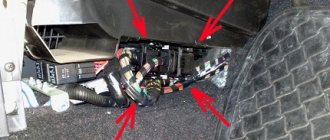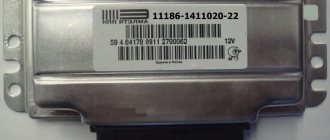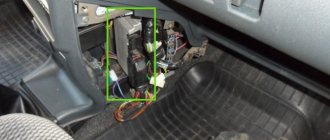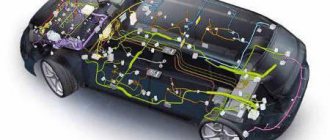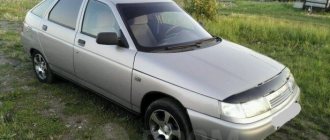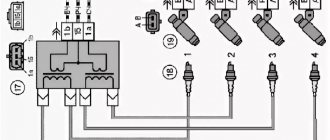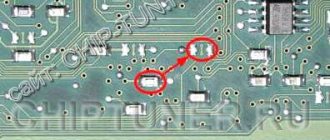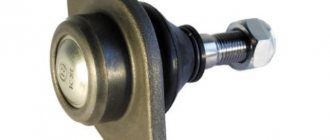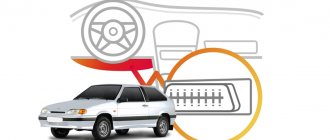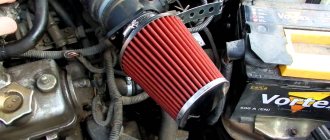Cars nowadays are becoming not only a luxury and a means of transportation, but also smart and advanced gadgets. What was once a horseless cart is now filled with electronics on par with good computers. And just as a computer has a central unit - a processor, an ECU is installed in a car, it is also an electronic control unit, it is also a controller, it is also “brains”. Everything that a modern car can boast of is, in most cases, the merit of not only engineers, but also programmers.
What is an ECU and where is it located?
How to “make friends” with each other the ABS system, engine, adaptive headlights, cooling and many other functional systems of the car? We need some kind of central coordinator in which the distribution and synchronization of information flows will take place. This function is taken over by the ECU, on which, without exaggeration, the operation of most components of the car depends.
An ECU is an electronic control unit that collects information from sensors, processes and issues commands to associated components and processes. A typical example is adjusting the fuel injection system depending on what data the oxygen sensor provides. Or, for example, turning on the cooling system fan when the antifreeze temperature reaches a critical point.
Physically, the ECU is a printed circuit board packaged in a plastic or metal case with connectors for connecting to a CAN bus, as well as a service connector to which diagnostic equipment is connected. The approximate dimensions of the block board are 10x15 cm with a thickness of 7-10 mm.
The controller is placed in the car out of sight, but so that it is easy to reach. Most often in the cabin, behind the front panel, behind the glove compartment or under the rear seat. A less convenient option is under the hood (and it is inconvenient primarily for the ECU itself, which suffers from moisture and temperature changes). Sometimes automakers locate the control unit in the trunk.
Location of the ECU in the Chevroelt AVEO in the T300 body
Location of the ECU in Lada Granta
Location of the ECU in the Hyundai Getz
What functions does the ECU perform?
Globally, four main functions of the controller can be distinguished.
- Collection of data from sensors (which, in turn, provide information about current processes in the car).
- Processing of received information.
- Management of processes and components associated with the ECU.
- Giving a signal about the current state of controlled processes.
Now a little more about the functionality of the control unit.
- Sensors convert information about physical processes (temperature, rotation speed, oxygen concentration in the exhaust, etc.) into electronic impulses and send it to the control unit. There are a huge number of sensors in a modern car, and each is important for the overall operation.
- The ECU processes the received information.
- Depending on the processing results, the controller sends commands to various components of the car, regulating all controlled processes.
- The ECU also sends signals to the control panel. It is thanks to this that we can monitor the temperature in the cooling system, engine oil level, etc.
How to find out which ECU is on the VAZ 2114 – January 7.2 January 4 Bosch M1.5.4
Today, there are 8 (eight) generations of electronic control units, which differ not only in characteristics, but also in manufacturers. Let's talk about them in a little more detail.
ECU January 7.2 – technical specifications
And so now we move on to the technical characteristics of the most popular ECU January 7.2
The ECU uses a Siemens Infenion C-509 processor (the same as the ECU January 5, VS). The block’s software is a further development of the January 5 software, with improvements and additions (although this is a controversial issue) - for example, an algorithm has been implemented, literally an “anti-shock” function, designed to ensure smoothness when starting and shifting gears.
The ECU is produced (хххх-1411020-82 (32), firmware begins with the letter “I”, for example, I203EK34) and “Avtel” (хххх-1411020-81 (31), firmware begins with the letter “A”, for example, A203EK34) . Both the blocks and the firmware of these blocks are completely interchangeable.
ECUs of series 31 (32) and 81 (82) are hardware compatible from top to bottom, that is, firmware for 8-cl. will work in a 16-cl. ECU, but vice versa - not, because the 8-cl. block “does not have enough” ignition keys. By adding 2 keys and 2 resistors you can “turn” an 8-cell. block of 16 cells. Recommended transistors: BTS2140-1B Infineon / IRGS14C40L IRF / ISL9V3040S3S Fairchild Semiconductor / STGB10NB37LZ STM / NGB8202NT4 ON Semiconductor.
Typical ECU parameters January 7.2 for diagnostics
ECU January-4 - technical specifications
Therefore, during development, the overall and connecting dimensions, as well as the pinout of the connectors, were preserved. Naturally, the ISFI-2S and “January-4” blocks are interchangeable, but are completely different in circuit design and operating algorithms. “January-4” is intended for Russian standards; the oxygen sensor, catalyst and adsorber were excluded from the composition, and a CO adjustment potentiometer was introduced. The family includes control units “January-4” (a very small batch was produced) and “January-4.1” for 8 (2111) and 16 (2112) valve engines.
ECU January 4 second generation of electronic control unit VAZ 2114
The “Kvant” versions are most likely a development series with J4V13N12 firmware in hardware and, accordingly, in software, are incompatible with subsequent serial controllers. That is, the J4V13N12 firmware will not work in “non-quantum” ECUs and vice versa. Photo of KVANT ECU boards and a regular serial controller January 4
ECU diagram January 4
Features of the ECM: without neutralizer, oxygen sensor (lambda probe), with CO potentiometer (manual CO adjustment), toxicity standard R-83.
Bosch M1.5.4 – technical specifications
For Euro-2 toxicity standards, new modifications of block M1.5.4 appear (has an unofficial index “N”, to create an artificial difference) 2111-1411020-60 and 2112-1411020-40, satisfying these standards and incorporating an oxygen sensor, catalytic neutralizer and adsorber.
The brains of the Bosch M1.5.4 ECU
Also, for Russian standards, an ECM was developed for 8-class. engine (2111-1411020-70), which is a modification of the very first ECM 2111-1411020. All modifications, except the very first, use a wideband knock sensor. This unit began to be produced in a new design - a lightweight, leak-proof stamped body with an embossed inscription “MOTRONIC” (popularly “tin can”). Subsequently, ECU 2112-1411020-40 also began to be produced in this design.
Replacing the structure, in my opinion, is completely unjustified - sealed blocks were more reliable. New modifications most likely have differences in the circuit diagram towards simplification, since the detonation channel in them works less correctly, the “tins” “ring” more when using the same software.
Itelma 5.1 - technical characteristics of the VAZ 2114 ECU
VS5.1 uses the same Siemens Infenion C509, 16 MHz processor, but is made on a more modern element base. Modifications 2112-1411020-42 and 2111-1411020-62 are designed for Euro-2 standards and include an oxygen sensor, catalytic converter and adsorber; this family does not provide R-83 standards for 2112 engines. For 2111 and Russia-83 standards Only ECM version VS 5.1 1411020-72 with simultaneous injection is available.
Itelma 5.1 - technical characteristics of the VAZ 2114 ECU
Design and principle of operation of the computer
The ECU housing serves to protect electronic components from the influence of external factors: moisture, mechanical damage and partly from temperature changes. If the unit is located in the engine compartment, the housing is made of aluminum. If the controller is located inside the car, where there are fewer adverse influences, the outer shell will most likely be plastic.
Chevroelt AVEO ECU in T300 body
ECU BOSCH M7.9.7
The board, which is located inside the case, resembles the motherboard of any computer or laptop, and even contains similar elements. In addition, the control unit has three types of memory.
- Programmable read-only memory, also known as PROM. This is where the software for performing all tasks is stored.
- RAM, also known as RAM. Just like in a computer, RAM is needed to process incoming information in real time. RAM does not record anything longer than the duration of data processing.
- Electronically reprogrammable storage device or EPROM. This is a semi-permanent memory that records data that changes over time: mileage, fuel consumption, access codes, etc.
Software or software is a package of specific programs necessary to control all systems of a particular vehicle. For each modification, its own software is created so that the control unit works correctly. It comes in two types: functional and control.
- Functional software is the very programs that are designed to control all the accountable systems of the car. They work with data coming from sensors, process this data in accordance with established algorithms and issue commands to related systems to regulate their operation.
- Control software is separate elements in which data received from sensors is compared with control indicators, and then errors are found and information about these errors is transmitted to the ECU. Depending on the severity of these errors, the control unit either corrects the operation of the vehicle systems to eliminate the cause, or turns on information icons on the control panel (for example, an oil or Check Engine icon), or completely blocks the engine from operating.
Where is the relay and fuse of the VAZ 2114 ECU located?
The main part of the fuses and relays is located in the mounting block of the engine compartment, but the relay and fuse responsible for the electronic control unit of the VAZ 2114 are located in a different place.
Relays and fuses of the VAZ 2114 computer
The second “block” is located under the dashboard on the front passenger side. To access it you just need to unscrew a few fasteners using a Phillips screwdriver. Why is it in quotes, because there is no such block, there is an ECU (brains) and 3 fuses + 3 relays.
ECU malfunctions and their symptoms
It is quite difficult to damage the ECU, but it is possible. Both hardware, that is, the board itself or its individual components, and software can fail. Physical malfunctions are always worse, since they cannot be resolved by flashing the firmware, but require repair or replacement of the device. Considering the cost of the controller, you can understand why, when the first suspicion of an ECU malfunction appears, you need to urgently solve the problem before it goes any further.
Troubleshooting
What are the causes of ECU damage?
- Physical impact on the device: shocks, falls, vibration.
- Water or oil gets on the board.
- Overheat.
- Short circuit.
- Corrosion.
- Incorrectly carried out “lighting”.
- Illiterate chip tuning.
Problems and malfunctions in the operation of the ECU primarily affect the operation of the engine, since it is this engine that most requires precision control.
How do ECU malfunctions manifest?
- Any engine malfunctions, unstable speed, increased fuel consumption, tripping, misfires.
- Difficult engine start, loss of precision and ease of control.
- Random activation or disabling of individual functions (for example, engine cooling fan).
- Fuses blow out periodically.
- Incorrect operation of the gas pedal - tight, with a slow response.
- Blocking of individual components - doors, clutch, engine itself.
- The error signal on the instrument panel lights up.
- When connecting a scanner, the system shows incorrect data.
How to remove and replace a faulty ECU on a VAZ 2114
When carrying out work to remove the VAZ 2114 ECU, do not touch the terminals with your hands. There is a possibility of damage to electronics due to electrostatic discharge.
- Using a screwdriver, unscrew the 3 screws securing the right panel of the instrument panel console and remove it.
- Release the clamp of the block with wires
- Disconnect the block from the ECU.
- Using a 10mm wrench, unscrew the 4 nuts securing the ECU to the bracket.
- We move the ECU forward and remove it from under the console.
- Remove the ECU from the bracket.
- Reinstall the ECU in reverse order.
ECU diagnostics
If you suspect a faulty ECU, diagnostics are needed urgently. But what to do if it is not possible to send the car to good specialists? How to check the condition of the control unit, and can you do it yourself?
In principle, you can check the ECU yourself.
The easiest and fastest way is to use a car diagnostic scanner. It is enough to have an ODB2 connector and an information output device (phone, tablet, laptop). Of those on the market, we can recommend Scan Tool Pro Black Edition.
This scanner is compatible with 99% of new and old cars, starting from 1993, is quite easy to use and has wide functionality. The advantages of this particular model include not only engine diagnostics, but also other vehicle systems. This device is not expensive (about 2000 rubles) and will pay for itself in 1-2 trips to the service station
Diagnostic process
For the other method, you will need a laptop and a diagnostic program (KWP-D is suitable in most cases). Also a special cable with a connector for the diagnostic connector on the control unit on one side, and a USB connector on the other. If you cannot find such a cable, you can try to find a USB adapter that supports the KWP2000 protocol. It will be cumbersome, but it will work. The main thing is that there is a connection to the laptop.
Procedure for diagnosing at home.
- Connect the adapter (cable) to the diagnostic connector on the ECU and laptop.
- Launch the diagnostic program.
- Turn on the ignition, but do not start the engine.
- After this, testing of the ECU will begin, after which a summary table will appear with important parameters of the vehicle systems.
If there really are errors in the operation of the engine and other components, they will be encrypted with the appropriate codes collected in the DTC section. You can see what a particular code means in the “Codes” section, and only after that analyze the state of the car’s systems and decide how to troubleshoot problems.
Other sections of the summary table of parameters that will be useful for assessing the condition of the car.
- UACC is a report on the condition of the battery, namely the actual voltage. Normal values are at least 11.5 V; if less, you need to look for a problem in the electrical network or in the battery itself.
- THR – throttle performance report. At idle it should be closed, that is, the sensor should show 0%. If the numbers are different, it’s time for service.
- QT – fuel consumption indicator. The consumption rate is 0.6-0.9 l/h. If more, you need to look for the cause, and first of all check the spark plugs.
- LUMS_W – crankshaft revolutions. At idle, it should rotate 600-1200 rpm, depending on the type of engine and its temperature.
Is it really advisable to diagnose the ECU yourself?
As usual, it all depends on the circumstances. And the first argument for learning how to check the control unit is a financial issue. Professional diagnostics will be quite expensive. In addition, it is not always possible to find a specialist who really understands electronics and software. More often you can find technical specialists who “float” in matters of electronics, but charge for their services at the level of professionals. You can contact such guys after the fact, when it becomes clear where to look for the problem.
Differences between control units
ECUs of older models worked with a limited number of sensors, so they could not ensure high-quality engine operation and preparation of the air-fuel mixture. The lack of support for the phase sensor (DPRV) led to the fact that the controller did not determine which cylinder was working at the moment, so it injected fuel not into the combustion chamber but into the air manifold. Devices operating in this mode were called central injection ECUs.
Installing a phase sensor on the engine made it possible to clearly determine the operating order of the cylinders, thanks to which fuel was calculated separately for each combustion chamber. Devices operating in this mode were called distributed injection ECUs. Over time, ECUs got better and better. Support for an oxygen sensor made it possible to more accurately regulate fuel combustion. Support for two oxygen sensors made it possible to move to higher toxicity standards, because in this case it was possible to effectively use the catalytic converter. The appearance of each new ECU model brought with it new functions that reduced fuel consumption, increased engine power or service life, and made driving more comfortable.
The controller is a complex electronic device, a microcomputer, so the breakdown or malfunction of any element leads to disruption of the functioning of the entire computer. In most cases, it is possible to determine an ECU malfunction only by elimination, checking the operation of the entire injector. For information on how to do this, read the article “Injector Diagnostics”.
Advice for motorists
If the ECU is faulty, try to repair it. But not on your own! It is better to entrust such delicate work to experienced craftsmen. A hardware problem most often arises from overheating, a short circuit, corrosion, or a burnt-out capacitor. The latter is the easiest to eliminate: the capacitor is simply soldered, and then you can use your control unit.
Corrosion damage can affect the tracks, and these too can (in theory) be repaired. The work is delicate, requiring skill, special tools, equipment and knowledge. So it’s better to send the controller in for repair and hope for the best.
Often problems with the control unit appear after an accident, even if it did not affect the unit itself. Impact or shock can damage an electronic device. Well, if there is visible damage to the case, this is in most cases a death sentence for the device.
Chip tuning is a lottery. If you want to take a risk (including money for a new ECU), you can try to improve the engine's performance. But such attempts often lead to the opposite effect, that is, a software failure, after which the unit requires flashing (not free, of course).
If you need to determine whether the problem is really in the ECU, or whether the mechanical part is “naughty,” you can find a similar working ECU and temporarily install it on your car. The problems have disappeared - change the control unit, the problems remain - it’s time to take a bow to the mechanics.
Among the reasons are:
- Mechanical damage (cracks, impacts, etc.);
- Exposure to moisture (“drowned people”, as well as cases where the car was stored improperly);
- Outside interference (reprogramming, incorrect firmware, etc.);
- Overheating or hypothermia;
- Voltage drops in the on-board network, as well as a short circuit (due to incorrect connection of the battery terminals, as well as attempts to “light” and other violations of the rules for operating the on-board network);
- Corrosion or oxidation of some areas of the board or other important elements of the ECU.
Car self-diagnosis
It should be noted right away that diagnostics on your own and at a service station are slightly different things. A specialized service has the necessary equipment that will allow you to fully identify all existing errors in the operation of your vehicle’s on-board computer.
VAZ 2114 car
Self-diagnosis is also a useful thing, but it is unlikely that you will be able to fully detect all errors if you check it yourself. It is also worth noting that the fault codes in both cases will be different, so we will consider both options separately. So, how is the dashboard diagnosed to identify faults without the participation of the on-board computer? This method is not known to all VAZ 2114 owners, but we will tell you about it.
- Sit in the driver's seat and hold down the odometer button.
- After this, turn the ignition key to the first position.
- Then release the odometer button: you will see the arrows begin to move.
- Press the button again and release it, so you will see the firmware version.
- Finally, press and release the button a third time and if there is a fault, you will see an error code on the screen.
Unlike diagnostics using specialized equipment, in our case you will only be able to see two-digit fault codes, not four-digit ones. Let's look at the most common failures found in VAZ cars.
| Code | Description |
| 1 | Microprocessor malfunction. |
| 2 | Malfunctions were detected in the gasoline level indicator sensor circuit in the fuel tank. |
| 4 | Too much voltage has been detected in the electrical circuit. |
| 8 | Voltage detected too low. |
| 13 | There is no signal from the oxygen indicator. |
| 14 | The antifreeze temperature indicator signal level is too high. |
| 15 | The antifreeze temperature indicator signal is too low. |
| 16 | Excessively high voltage level in the on-board network. |
| 17 | The voltage level in the on-board network is too low. |
| 19 | Incorrect signal from the crankshaft position lock element. |
| 24 | The vehicle speed sensor is not working. |
| 41 | Incorrect phase sensor signal. |
| 51 | Malfunctions have been detected in the operation of the permanent storage device. |
| 52 | Malfunctions have been detected in the operation of the random access memory device. |
| 53 | The CO potentiometer has failed. |
| 61 | Malfunction of the lambda probe. |
Laptop for vehicle diagnostics
It is necessary to take into account the fact that errors can add up, that is, if you have malfunctions with codes 1 and 4, then the number 5 will appear on the screen. It should also be noted that all malfunctions will be stored in memory until until they are reset manually. To do this, with the ignition on, disconnect the terminals from the battery and wait a few seconds, then connect them back. This way, errors will be reset manually and you won’t have to pay your hard-earned money to specialists.
Video “Why the ECM does not communicate during testing”
Get chip tuning done by a trusted specialist with a certificate and the possibility of moneyback.
ADACT against removing a correctly functioning catalyst. Find out about the possible consequences for the car.
The electronic engine control unit (ECU, ECU or, more precisely, ECM and PCM) is the center that integrates the various subsystems of the car. The “vitality” of the entire car depends on the correct functioning of this unit: it controls the operation of the engine so that it produces optimal performance. That's why they say that the engine is the heart of the car, and the ECU is its brains.
Appearance of the ECU January 7.2
Identifying faults that have arisen in engine control
The causes of engine control unit breakdowns are divided into two main types: faulty conductor or firmware failure. The firmware can only be restored with the help of specialists at the service center. You can check the electrical parameters yourself using a special measuring device - a multimeter.
To search for a breakdown in the wire, you need to familiarize yourself with the diagram of the control device. Having studied the location of conductors, resistors and power, it is time to “check” the electrical circuit in the place where an error in the readings of the electronic unit is detected. In the absence of such information, it is necessary to check the wires throughout the entire circuit.
Description of the main reasons for ECU failure
The list of most likely causes includes the following factors:
- Microcracks in the circuits and body of the device caused by mechanical stress (shocks, strong vibrations).
- A sharp increase in temperature leading to overheating of the motor control unit.
- Destruction of ECU elements due to corrosion.
- Penetration of moisture into the controller housing due to its depressurization.
- Incompetent repair actions.
- Applying the “lighting up” effect while the engine is running in order to help the neighboring car.
- Changing the position of the terminal connections while connecting the battery.
- The power bus is not connected when the starter is turned on.
The efficiency of the ECU fully depends on the listed factors, many of which can cause significant harm to the control device.
To prevent permanent breakdowns, it is necessary to carry out regular diagnostics of the electronic engine control. In order to save on expensive repairs and complete replacement of electronic control system elements, the inspection is carried out at least once a year.
